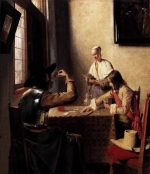Empirical Evidence
Evidence from observations
Repeatedly in his letters, Leeuwenhoek calls what he does waarnemingen, observations. His first question was always: What am I seeing? It was a new world that no human had ever seen before, so he had to describe it accurately.
Hooke's best-selling Micrographia was organized as numbered Observations. To him, the new, Bacon-inspired science did not need "strength of Imagination and exactness of Method" or "depth of Contemplation". It needed:
a sincere Hand and a faithful Eye, to examine, and to record, the things themselves as they appear.
To Hooke, accurate observation is itself a desirable form of knowledge. Many articles throughout the early years of Philosophical Transactions have "observations" in the title.
These observations were not always self-evident or easily accomplished. In June 1699, Leeuwenhoek wrote:
for it doth happen often to me, that People looking through a Magnifying-glass, do say now I see this, and then that, and when I gave them better Instructions, they saw themselves mistaken in their opinion,
and what is more, even he that is very well used to look through Magnifying-glasses, may be misled by giving too sudden a Judgment of what he doth see.
Evidence from experiments
Leeuwenhoek also described experiments, that is, things he did to answer his next question: what if?
In his third letter (illustration on left) to Henry Oldenburg, April 7, 1674, Leeuwenhoek writes about an experiment he made to test his hypothesis that, because there are no vacuums, air cannot be compressed either. Minute particles, "the first and finest matter of Air", must be passing through the walls of whatever chamber contained the air. To test this, he tried to press particles through glass.
It didn't work (explanation on left).
What motion soever I make with the forcer, and press out the Air, the water at the small hole keeps its station.
But the experiment raised new questions.
And yet, if I do but apply my warm hand to the exterior pipe, the water presently flies out. This puzzles me; nor can I find a satisfactory reason for this Phenomenon.
 As Leeuwenhoek kept gaining experience and expertise, his experiments became more sophisticated. His long series of experiments with various water infusions culminated in the long letter of October 9, 1676: "Observations concerning various little Animals, in great numbers discover'd by Mr. Leewenhoeck in Rain- Well- Sea- and Snow-water; as also in water wherein Pepper had lain infused."
As Leeuwenhoek kept gaining experience and expertise, his experiments became more sophisticated. His long series of experiments with various water infusions culminated in the long letter of October 9, 1676: "Observations concerning various little Animals, in great numbers discover'd by Mr. Leewenhoeck in Rain- Well- Sea- and Snow-water; as also in water wherein Pepper had lain infused."
Henry Oldenburg published it the following March in Number 133, just ahead of the article reprinted from France's Journal des Scavans by Giovanni Cassini announcing his discovery of the two "planets" around Saturn.
The next number, the next month, Oldenburg published van Leeuwenhoek's equally important letter of March 23, 1677: "Monsieur Leewenhoecks Letter giving some account of the manner of his observing so great a number of live Insects in several sorts of water".
While Leeuwenhoek's procedures can be seen as lacking according to modern scientific standards, a reading of other articles in Philosophical Transactions shows that his experiments were as controlled and documented as those of his peers. In the 1934 article Leeuwenhoek as Experimental Biologist, Stanford University anatomist A.W. Meyer writes that Leeuwenhoek
... experimented ... in a truly modern way not in one but in many fields, including biology, physics, chemistry and petrology. In the first of these, which is the one that concerns us here, his experiments fall under the heads of toxicology, physiology, genetics, economic entomology, veterinary medicine, therapeutics, pharmacology, and reproduction in the older and broader sense of that word.
Meyer's twenty-page article recounts dozens of Leeuwenhoek's experiments, among them:
- toxicology experiments with spiders and frogs, nutmeg and mites, and pepper and microbes (diertgens)
- reproduction experiments (to test theories of spontaneous generation) with maggots and cheese and with post-copulatory rabbits
- pharmacology experiments on the efficacy of remedies such as moxa and cinnamon.
Meyer concluded that "it would be difficult to find a more unfettered, faithful and objective searcher than the candid cloth-merchant of Delft."







